by Winding Pathways | Jul 4, 2024 | (Sub)Urban Homesteading, Bugs, Garden/Yard, Garden/Yard, Nature
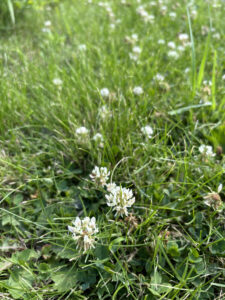
Mowers pass over low-growing clovers.
We recently discovered an amusing irony created by one of the most common lawn plants – white clover.
Sometimes called Dutch Clover, this low-growing plant graces unsprayed lawns in temperate regions across the globe. Normally, we discourage nonnative plants at Winding Pathways, but clover is an exception.
Although native to Eurasia, it’s not invasive. This important forage legume is likely the most widespread in the world. Diminutive clover is so low growing our mower passes right over its dainty flowers. Our friendly cottontail bunnies may seem to be eating grass, but actually, they’re feasting on clover. So are beneficial insects. As its flowers add beauty to the lawn and feed animals, clover’s roots pump nitrogen into the soil, helping other plants grow.
The irony
AI detected our Internet search for clover information. We began getting computer ads from landscaping companies encouraging us to hire them to kill our clover “and other weeds” in our lawn. No way!
Many people spend good money to poison beneficial lawn plants. They expose themselves, their pets, and anyone who walks on the lawn to toxic substances.
Maintaining a Healthy Bed of White Clover
White clover tends to gradually decline over the years. We’ve noticed this at Winding Pathways. To give it a boost we buy white clover seeds and sprinkle them on the lawn during cool months, especially on bare spots. Seed can be purchased online and in stores where hunters shop. These stores sell seeds beneficial to wildlife, and hunters often plant them to boost food for deer and wild turkeys.
-
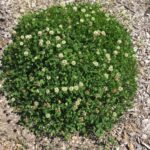
-
Clover can be manicured.
-
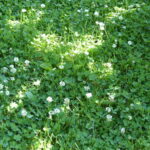
-
Sunlight on a clover lawn forms a cross.
-
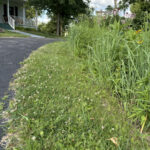
-
Dutch White Clover is low-growing.
Rewards
We have healthy lawns, rich with nitrogen. And, on summer mornings and evenings, we sit in our front porch’s rocking chairs watching bumble bees and bunnies foraging on our blooming white clovers. Thanks, clover.
-
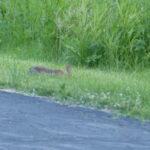
-
Bunnies enjoy clover.
-
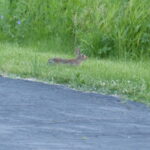
-
Watchful
by Winding Pathways | Apr 18, 2024 | (Sub)Urban Homesteading, Garden/Yard, Garden/Yard
Spring Ritual
After this weird winter, most of us in North America are simply ready for spring and want to get outside. Some folks take initiative and start garden and flower seeds indoors then transfer them outside when the weather moderates.
Are you ready to work the land? Try something new: No-till Gardening.
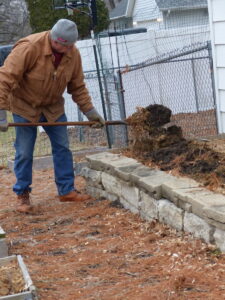
A rite of spring.
For generations, an April ritual all across the northern hemisphere is pulling the spading fork out of storage and firing up the rototiller. For generations, gardeners have learned from mentors, books, and videos that tilling is essential to create an abundant harvest of tomatoes, peas, beans, carrots, and so many other delicious garden vegetables.
Over decades and diligent research, we have learned that tilling is often just extra work that might harm the soil! Try no-till gardening.
Science Writer Shares Information
We recently heard science writer, author, and land steward Connie Mutel speak about how Iowa’s amazingly productive topsoil is being degraded by annual plowing and otherwise disturbing the soil. Mechanically mixing soil bares the soil to the air, where it oxygenates, leaching carbon into the atmosphere. When winds blow or rains fall, bare soil erodes. Waterways become contaminated and silt washes downstream eventually to the Mississippi Delta resulting in damage to commercial fisheries and wildlife there. According to Mutel, half of Iowa’s once 16-inch veneer of topsoil has been lost by tillage. For much more information check out her books available at the University of Iowa Press-uipress@uiowa.edu.
Reduce Runoff and Work
Most people aren’t farmers but many of us have backyard gardens. An annual activity is tilling. For years we followed conventional wisdom and used our trusty spading fork to turn over the soil each spring. Not so much anymore.
Last year encouraged by Drew Erickson, Farm Manager, of the Rodale Institute’s Midwest Organic Center, we left about half the garden untilled. “Tilling disrupts the organisms that make soil healthy and productive. “Try no-till gardening. Just plant your seeds in untilled soil,” he advised.
Last spring we tilled half the garden, smoothed out the soil, and planted our seeds.
We didn’t till the other half and just planted the seeds directly into the soil. A few months later we harvested at least as many vegetables from the no-tilled areas as the tilled……and we’d avoided the pitchfork work.
-
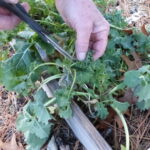
-
We planted kale directly into the ground with good results.
-

-
Summertime meal from the garden.
This year we’ll only till about a quarter of our garden. Into the rest we’ll plant our seeds and spread a layer of compost directly on the soil surface after the sprouts emerge.
We’re counting on bountiful harvests of many vegetables.
Join the Project
Give it a try. Put onion and potato sets, tomato plants, and bean seeds directly into the untilled garden soil. Let us know the results.
Learn More
Rodale Midwest is holding a free field day to show the value of minimum tillage and cover crops. It’s geared for farmers but gardeners are welcome. To register for the July 9, 2024, workshop go to the Rodale Institute Midwest Organic Center.
Have fun in the garden and enjoy a season of delicious vegetables.
by Winding Pathways | Mar 21, 2024 | Garden/Yard, Garden/Yard, Trees
Bright! Beautiful! Ominous!
As we walked across a New Jersey parking lot last summer an amazingly colorful, and new-to-us, insect fluttered in front of us. It had a gorgeous creamy white and bright red body covered with black spots.
Identifying it was easy and ominous. It was a Spotted Lanternfly. First found in Pennsylvania in 2014 it likely came to the United States from its native China as a hitchhiker in a crate or box.
It may be a pretty bug but its presence is ominous. It feeds on at least 172 different plant species and is spreading rapidly westward from its start close to the Atlantic Ocean.
Feeding off Another Invasive
What’s somewhat ironic about the lanternfly is the insect’s affinity for another Chinese invasive, the Tree of Heaven or Ailanthus. Although the inch-long insect will eat many different plants it prefers this highly aggressive and fast-growing tree.
Important Contact Information
The Iowa Department of Agriculture and Land Stewardship is on the lookout for the Spotted Lanternfly. They ask anyone spotting one in Iowa to report it by calling:
l (515)725-1470 or logging onto their website at IowaAgriculture.gov.
How To Reduce the Invasion
A key to reducing this insect’s abundance may be reducing Ailanthus tree numbers. This invasive tree thrives in urban and rural areas, often forming large groves. It displaces native trees, has little commercial value, and now harbors an introduced insect pest.
Winding Pathways encourages anyone with an Ailanthus in their yard to remove it, convert it to firewood if you can, and replace it with a native tree species. Remember, report any Spotted Lanternflies you spot.
-
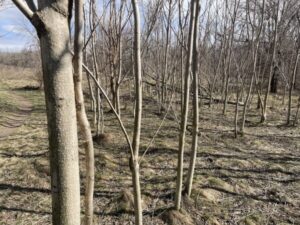
-
Grove of young Ailanthus.
-
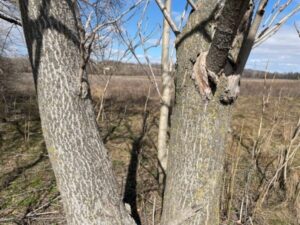
-
Ailanthus trees grow fast.
by Winding Pathways | Nov 30, 2023 | (Sub)Urban Homesteading, Garden/Yard
On Fire?
Many readers know we burn our yard. What? Are we nuts? Fire kills. Fire destroys. Well, it can but it also cleanses and heals.
It’s one way to manage natural growth on properties. So, on a balmy early November day, we set our yard on fire! Flames towered over the yard as intense heat pushed outward.
We usually burn smallish prairies we’ve planted in both our front and back yards. Years ago, we usually burned in March but more recently we’ve shifted to November. Burning in fall seems to encourage wildflower blooms next summer.
Preparation is the Key
We’re unusual but not reckless. (A good read is at this address. www.prairienursery.com/media/pdf/burn-your-prairie-safely.pdf.) Before burning we did these things:
- Mowed a wide firebreak around our proposed burn area. Closely clipped lawns are nearly as effective as a firebreak as pavement or bare soil.
- Acquired a fire permit from Linn County Public Health.
- Found friends and neighbors to help us manage the burn.
- Ahead of time educated neighbors about the value of burning and then alerted them of our plan to burn in a certain time frame.
- Had appropriate tools on hand before we burned. These included garden rakes, matches, and both a portable fire pump, called a “Smith Indian”, and a hose stretched to the burn site.
-
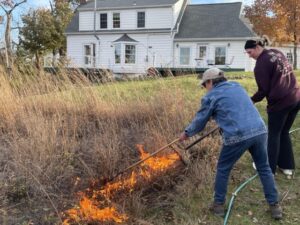
-
Workers spread flames.
-
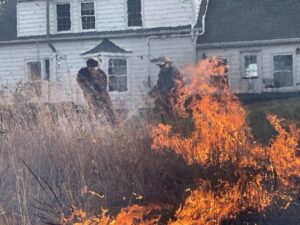
-
Working together.
Important Last-Minute Steps
On the day of our proposed burn, we did what the Health Department requires and first checked the air pollution report. We are only allowed to burn when the air quality is good, so jump online to a local map that shows real-time air quality. If the air quality is good, we call the sheriff’s department before burning. This is so that if someone reports smoke or fire, they know not to send out firefighters.
A light breeze helps push the fire through standing dried-out prairie grass, but too much wind can be dangerous. Our permit allows us to burn only if the wind is 20 mph or less.
Consideration of Neighbors
Because busy 30th Street Drive is our south property border we burn only when a south wind will push smoke away from the road and neighbor’s homes. North of our property is a large woodland where no one lives and there’s plenty of space for the smoke to disperse.
Rewards After Burning
Burning takes planning and preparation but the actual burn is over in a flash. On November 5th we were all ready, called the sheriff, and lit the prairie just after 3 pm. Flames roared through the grass and stopped dead when they reached our mowed lawn. Less than an hour after striking the match our fire was completely out and we were munching on pizza.
Most homeowners can’t burn, but many can. It’s an interesting and natural way to manage property. And, it’s fun.
by Winding Pathways | Aug 3, 2023 | Garden/Yard, Nature, Wonderment
At the foot of East Post Road SE, just by Indian Creek is the frog statue that dons varied outfits each season and for many events. Take a look through the years. And visit our website for amphibian blogs.
The frog is serious about keeping healthy and helping after storms.
-

-
Masks and hand sanitizers did their jobs to help reduce the spread of SARS-CoV-2
-
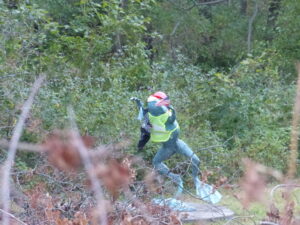
-
Cleaning up after the 2020 Derecho.
Further into the year:
-

-
A green pot of gold.
-

-
Hoppy Easter!
-

-
Keeping it Clean
Middle of the Year is graduation, summer fun, and the Fourth of July with a loyal “Vandal” from Idaho!
-
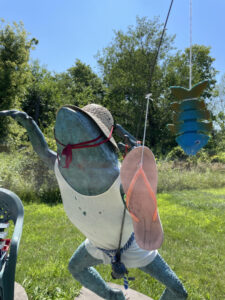
-
Summertime and the livin’ is easy.
-

-
Frog And Vandal (UIdaho) posing.
-

-
Amphibian Safety Patrol…
-

-
Go Hawks!
-

-
Does this frog practice Reiki?
-

-
Coming for the candy.
Always a civic Duty Calls.
-

-
Research first.
We are “hopping” to add more photos as we walk by the ever-current and exciting Frog Statue. To learn about real frogs of Iowa visit the website link.
by Winding Pathways | Apr 20, 2023 | (Sub)Urban Homesteading, Garden/Yard, Garden/Yard
People make a “to-do” about moles. They might be the most disliked animal in suburbia. We have them at Winding Pathways and are sharing tips on what we do about them.
Human Created Problems
Suburban and urban soil has a common problem. It is too often compacted. Construction companies often scrape topsoil off a yard before building a house. Then, they drive vehicles in the yard. When a family moves in, they soon create a dog run, drive their cars on the grass, and play on the lawn. Too many footsteps by pooches or people compact the ground.
Nature Has Solutions
Lawn plants struggle to thrive in tight soil, but nature has a remedy. Fossorial animals live in the soil and include moles, gophers, shrews, ants, worms, and others. Their burrowing constantly mixes and softens the dirt they live in, making it easier for plants to live.
Moles or Gophers?
People often confuse moles with gophers, but it’s easy to tell them apart. Moles prefer living in moist shady places and are at home in suburbia. They eat grubs and worms. Gophers, in contrast, are more likely to live in rural sunny pastures with dry soil and mostly eat roots. Mole hills are symmetrical, like mini volcano cones. Gophers, in contrast, make elliptical hills.
What Do You Really Value?
Ironically, most people who trap or poison moles profess to love a rich, green, “healthy” lawn, ignoring that nature loves diversity, not monocultures. Moles help make healthy lawns happen. Granted their hills of dirt and heaped linear tunnels can be unsightly and catch lawn mower blades.
Here is what we do at Winding Pathways:
- Thank our moles for helping make the soil soft and fertile.
- Rake out their hills before mowing.
- Stomp down their raised tunnels so our lawn mower does not catch on them.
- Enjoy the diversity of life in our yard.
Moles are as fascinating and beneficial as the butterflies that pollinate blooms or the cardinals who pluck seeds from feeders. They deserve respect for their valuable work.
-
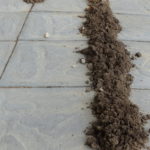
-
Moles bring rich dirt from below to the surface as they tunnel along hunting for earthworms and grubs.
-
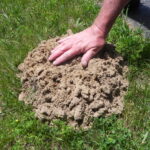
-
Moles sometimes push up excess dirt.
-

-
Moles’ feet are made for clearing dirt away.




























